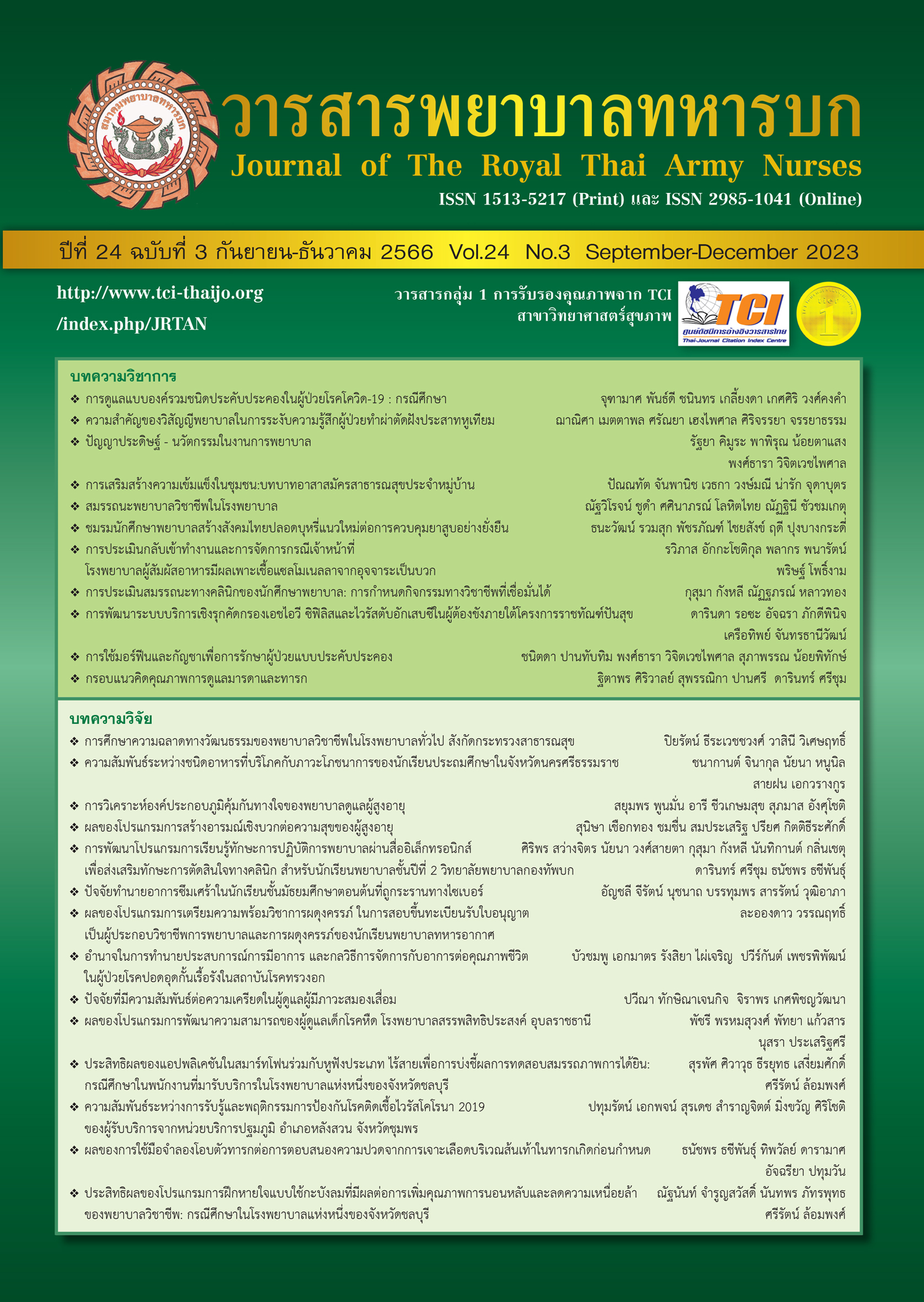The Relationship between Family Factors and Health Literacy of Adolescence Pregnancy Prevention among Teenagers in Pa O Don Chai Sub-district, Mueang Chiang Rai District, Chiang Rai Province.
Keywords:
family function, health literacy, adolescence pregnancy preventionAbstract
The descriptive research design aimed to examine the relationships between family structure, family function and health literacy of adolescence pregnancy prevention. The sample were 70 adolescents, randomly selected by proportion of each village. The research instruments were questionnaires of personal factors, family function, and health literacy of adolescence pregnancy prevention. Reliability was established and the Cronbach’s alpha coefficients were .89 and .81-.89 respectively. The data were analyzed by using descriptive statistics, Chi-square, and Pearson’s correlation. The results revealed that:
1. The most of family structure were two generation family (43.70%). The overall of family function was at a fair level ( = 3.22, S.D. = 1.12) and the overall of health literacy of adolescence pregnancy prevention was at a good level (
= 116.54 S.D. = 12.20).
2. The relationship between family structure and health literacy of adolescence pregnancy prevention was statistically significant (x2 = 29.815, p<.05).
3. The relationship between family functions in problem solving, communication, roles, affective responsiveness, general function, and family functions in overall and health literacy of adolescence pregnancy prevention were positively statistically significant (r = .315, .462, .331, .347, .400 and .404 respectively, p<.01). From the results of this study, the relevant agencies should promote family functioning and support family to participate in health literacy of adolescence pregnancy prevention development.
Downloads
References
Nkhoma DE, Lin CP, Katengeza HL, Soko CJ, Estinfort W, Wang YC, Juan SH, Jian WS, Iqbal U. Girls’ empowerment and adolescent pregnancy: A systematic review. International journal of environmental research and public health. 2020;17(5): 1-14.
Iaimkhong P. Statistics on adolescent births, Thailand 2021. Nonthaburi: Bureau of Reproductive Health, Department of Health; 2021. (in Thai)
de la Calle M, Bartha JL, Lopez CM, Turiel M, Martinez N, Arribas SM, Ramiro-Cortijo D. Younger age in adolescent pregnancies is associated with higher risk of adverse outcomes. International Journal of Environmental Research and Public Health. 2021;18(16): 1-11.
Kawansu P, Sereethammapithak P, Khavansu A. Factors affecting unwanted pregnancy in adoles cent girls, Nakhon Phanom province. Journal of Environmental and Community Health 2023; 8(1): 324-36. (in Thai)
Ahinkorah BO, Kang M, Perry L, Brooks F, Hayen A. Prevalence of first adolescent pregnancy and its associated factors in sub-Saharan Africa. PLoS One. 2021;16(2): 1-16.
Wado YD, Sully EA, Mumah JN. Pregnancy and early motherhood among adolescents in five East African countries: A multi-level analysis of risk and protective factors. BMC Pregnancy and Childbirth. 2019;19(1):1-11.
Miedema E, Le Mat ML, Hague F. But is it comprehensive? Unpacking the ‘comprehensive’ in comprehensive sexuality education. Health Education Journal. 2020; 79(7):747-62.
Dongarwar D, Salihu HM. Influence of sexual and reproductive health literacy on single and recurrent adolescent pregnancy in Latin America. Journal of Pediatric and Adolescent Gynecology. 2019; 32(5):506-13.
Education and Communications, Division of Health Promotion, Health Education and Health Promotion Unit World Health Organization. Health Promotion Glossary. Switzerland: Geneva; 1998.
Nutbeam D. Health literacy as a public health goal: A challenge for contemporary health education and communication strategies into the 21st century. Health Promotion International. 2000; 15(3): 259-67.
Racine N, Eirich R, Dimitropoulos G, Hartwick C, Madigan S. Development of trauma symptoms following adversity in childhood: The moderating role of protective factors. Child Abuse & Neglect. 2020; 101, 104375.
Khaosaard M. Thai people’s life in two decades of development. School of Public Policy, Chiang Mai University; 2013. (in Thai)
Thaipiboon P, Madiloggovit C. Problems in learning for skipped-generation family to promote child well-being based on the family ecology framework. Journal of Education Studies. 2021; 49(3): 1-15. (in Thai)
Trangkasombat U. Family functioning in the families of psychiatric patients: a comparisonwith nonclinical families. Journal of Medical Association of Thailand. 2006; 89(11):1946-53.
Miller W, Ryan E, Keitner I, Bishop S, Epstein B. The McMaster approach to families: Theory, assessment, treatment. Journal of family therapy. 2000; 22(2):168-89.
Bianchi D, Morelli M, Baiocco R, Cattelino E. Family functioning patterns predict teenage girls’ sexting. International Journal of Behavioral Development. 2019; 43(6): 507-14.
Ngomsangad Y, Srisuriyawet R, Homsin P. Factors influencing health literacy related pregnancy prevention among female adolescent students in Si Sa Ket province. The Public Health Journal of Burapha University. 2019; 14(2): 37-51. (in Thai)
Seedaket S, Chotchai T. Health literacy of school-age pregnancy prevention and sexual intercourse among high school students in Khon Kaen Province. Journal of Health and Nursing Research, 2021; 37(1): 99-111. (in Thai)
Srisathitnarakoon B. Effect size, power analysis, optimal sample size calculations using G*Power software. Bangkok: The Chulalongkorn University Press; 2020 (in Thai)
Kirdchok P, Taepakdee J, Chinvararak C. Parent-adolescent relationship patterns of junior high school in Ubonratchathani province and its association with family factors. Vajira Medical Journal: Journal of Urban Medicine. 2022; 66(4):245-56. (in Thai)
Health Education Division. Health literacy scale for unwanted pregnancy prevention of Thai female adolescents. Bangkok: Health Education Division. 2014. (in Thai)
Office of the Permanent Secretary. Social situation report for the year. Ministry of Social Development and Human Security. 2022. (in Thai)
Portawin T. Strengthening of the warmness for specific family in the Target areas of the warmth family. Journal of Social Work. 2020; 28(1):197-234. (in Thai)
Pingwong K, Kaewkanta P, Chaimin U, Pingmuang M. Relationship between self-esteem, health literacy and adolescents’ pregnancy preventive behaviors of vocational institutes in Chiang Rai Province. Journal of Nursing and Health Sciences. 2023; 17(1): 1-14. (in Thai)
Euamornvanich P. Social media literacy of Thai adolescents in Bangkok Metropolitan. Silpakorn University Journal. 2023; 43(3): 97-109. (in Thai)
Downloads
Published
How to Cite
Issue
Section
License
Copyright (c) 2023 Journal of The Royal Thai Army Nurses

This work is licensed under a Creative Commons Attribution-NonCommercial-NoDerivatives 4.0 International License.
บทความหรือข้อคิดเห็นใดใดที่ปรากฏในวารสารพยาบาลทหารบกเป็นวรรณกรรมของผู้เขียน ซึ่งบรรณาธิการหรือสมาคมพยาบาลทหารบก ไม่จำเป็นต้องเห็นด้วย
บทความที่ได้รับการตีพิมพ์เป็นลิขสิทธิ์ของวารสารพยาบาลทหารบก
The ideas and opinions expressed in the Journal of The Royal Thai Army Nurses are those of the authors and not necessarily those
of the editor or Royal Thai Army Nurses Association.






